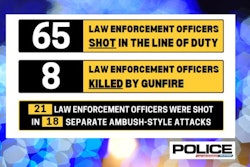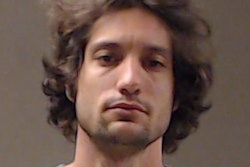 The Brookhaven Police Department (GA) became the first in the southeastern United States to launch a Drone as First Responder program.Wayne Parham
The Brookhaven Police Department (GA) became the first in the southeastern United States to launch a Drone as First Responder program.Wayne Parham
Although not even 10 years old yet, the Brookhaven Police Department (GA) has established itself as a technology leader and was the first in the southeastern United States to launch a Drone as First Responder (DFR) program.
However, Brookhaven officers are quick to give credit to the Chula Vista Police Department (CA) for pioneering the DFR concept of dispatching unmanned aerial systems (UAS) in response to emergency calls beyond visual line of sight, which required an FAA waiver. A typical DFR program uses drones, stationed at permanent locations throughout a city, that launch and can put eyes on the scene before officers arrive.
A New Department
The City of Brookhaven incorporated in December 2012 from an unincorporated part of Dekalb County in the metropolitan Atlanta area. Several months later, in July 2013, the city created the Brookhaven Police Department. The department serves more than 56,000 residents in an area of about 13 square miles. Chief Gary Yandura was tapped to build the department and continued at the helm until last fall when he retired and passed the torch to Chief Brandon Gurley, who had been the first officer hired by Yandura.
Prior to the formation of the city, the area was served by a county police department and reportedly had only two officers assigned to cover the region. Residents were glad to finally have their own police department. That strong public support continues now as police deploy technology such as ALPRs, DFR, and more recently, Live 911.
Gurley, once named chief, created focus groups to gather community feedback. A facilitator asked participants what the number one thing was that they liked about the Brookhaven Police Department.
“The number one response was our innovation,” says Lt. Abrem Ayana, sUAS program manager.
Foundation of Trust
Police in Brookhaven believe strong relationships with the community, building trust, and providing transparency are all prerequisites for a police department to even consider a DFR program.
“You can't do this without citizens’ support. They support us, they know that we're fair, we’re just, the service is going to be good, and that we don't tolerate bad behavior,” says Ayana. “We've established that we can police ourselves.”
He says people need to know that police are not using the drones to fly over the local pool and spy on women sunbathing or to look in their backyard to see if they're growing marijuana, unless officers have a warrant. Before launching the drone program, Brookhaven police entered into an agreement with the district attorney and the American Civil Liberties Union (ACLU) that pledges no drone footage will be released of individuals who are not engaged in criminal activity.
“If we fly a drone out to a call and you don't go to jail, we don't release the video,” Ayana explains. “There’s a lot of video we don’t release.”
As soon as a DFR drone is launched, it is focused on trying to get a view of the incident scene as soon as possible. Other than that, the camera is pointed forward as it flies and not aimed down viewing anything it passes over.
While some communities might react with a “Big Brother is watching” outcry when departments start drone programs, that was not the case.
“We never hear that complaint. Never. Not one person has come in and said it. And if you went back and you looked at our social media pages and posts related to the drone program, you may see one or two people who are skeptics, but oftentimes they don't live in Brookhaven,” Ayana explains.
Also, for transparency, after every flight Brookhaven provides a link on the departmental website to show a map of the flight path. Drone flight data is provided by Motorola Solutions' CAPE software.
The Need
Ayana, who at the time was a patrol commander working nights, says back in the summer of 2020, Brookhaven was plagued with a rash of auto break ins.
Although the department could request helicopter support from the Georgia State Patrol or the Dekalb County Police Department, Brookhaven needed a solution that could provide a quicker response. At first when launching a drone program was considered it was thought it could not be done because of the proximity to Peachtree-Dekalb Airport (PDK). The Class B airport is the second busiest in Georgia and has averaged 230,000 takeoffs and landings annually for more than three decades.
“Their runway, their approaches, and their takeoff and landings all in Brookhaven air space,” says Ayana.
Brookhaven’s DFR software contains geofences that limit the flight altitudes of the drones based on a series of grids. Some are as limited as 50 or 100 feet, so the drones don’t typically fly there. Areas at PDK are 0, meaning a no-fly area. The department works closely with the PDK airspace manager.
“So now we're working on a plan to go to the FAA to get permission to fly higher and easier,” Ayana says. “We feel confident that we'll be able to get higher. That'll actually unlock some abilities for us.”
In the event police need to fly a drone over an incident at the airport or extremely close to PDK, there is a procedure. Police make a quick call to the Federal Aviation Administration in Washington, D.C., and get prompt approval.
Getting Started
Ayana reached out to the Chula Vista Police Department after seeing a video they had posted about their DFR program. He also talked to Flying Lion, the company that provides drone pilots to Chula Vista by contract.
A Flying Lion representative visited Brookhaven and gave a presentation. Where Chula Vista uses those Flying Lion pilots in command in conjunction with a teleoperator that is both a sworn officer and an FAA Part 107 drone pilot, Brookhaven decided to launch a DFR program solely using officers certified as pilots.
Ayana continued doing the research during the summer of 2020 and then the idea went to the city council for approval. The Brookhaven DFR drones are flown from the private rooftops, so city lawyers needed time to work out agreements with those property owners. The DFR program then took to the air in April 2021.
The Brookhaven DFR program flies two DJI Matrice 300 RTK drones. The M300 is equipped with a Zenmuse H20T camera capable of thermal imaging and can be equipped with a 10,000-lumen gimballed spotlight and a loudspeaker. Ayana points out that although those are Chinese-made drones, the department does not use the DJI software. Instead, a Motorola app is used to control the flights.
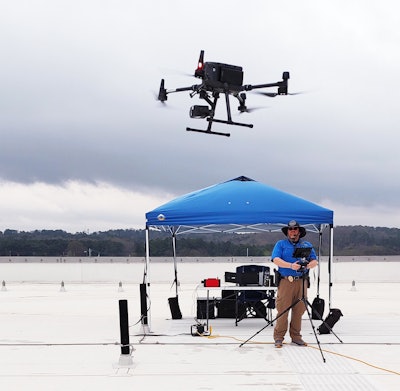 Sgt. Matt Murray, a rooftop pilot, flies the DJI Matrice 300 RTK.Wayne Parham
Sgt. Matt Murray, a rooftop pilot, flies the DJI Matrice 300 RTK.Wayne Parham
Flight operations usually entail two officers. One is on the rooftop and can prep the drone for flight, change batteries, or take over a flight when needed. Typically, the flight is piloted by a teleoperator inside police headquarters. Both are sworn officers and both are certified drone pilots.
The DFR drones cannot reach every area within the city and usually only one or the other is chosen to fly on a given day. However, Brookhaven has a plan to provide coverage to areas out of reach for the main DFR drones. A portable scaled down version of the DFR drone is kept in a case at the police department and can deploy quickly.
“We take this, with this monitor, and this power pack to power this monitor for up to 10 hours. I’ve got my batteries right here, my flight controller, and can be completely capable of running an operation,” he says. “We're building our drone program to be able to respond to all incidents. So, we can take this anywhere anytime of the day and be operational in less than 10 minutes.”
Demonstrating Success
In May of last year the mayor had just asked for an update on the DFR program. That same day, the DFR program was pressed into service during the arrest of two potentially dangerous individuals outside a CVS Pharmacy. Following the Chula Vista model, Brookhaven shares video from some of its DFR successes on social media. This is one such case.
A car taken during a robbery and shooting in Charlotte, NC, entered Brookhaven and was detected by automatic license plate reader (ALPR) cameras. A drone was deployed looking for a Honda that fit the description of the suspects’ vehicle and initially eyed one getting on the interstate. But, that turned out not to be the suspects’ vehicle.
Soon after, an officer radioed that he had found the car in the parking lot of a CVS and he had detained one suspect. Another male suspect exited the store and upon seeing police, ran back inside. He ran through the store and exited through a rear door, but the DFR operator was watching as he fled, jumped a fence, and hid in some brush. The pilot was able to direct officers to surround the area. A canine was dispatched and while it was enroute the drone returned home for a battery replacement and then came back to the scene. The teleoperator was able to direct the ground officers who took the suspect into custody without incident.
“That drone was there and we got a really bad guy off the street, convicted felon in possession of a gun. We got the car, we got the gun, we got the money, we got the two bad guys because all of that came together. This is really beautiful to see it all come together,” says Ayana.
Another example demonstrates just how quickly a DFR drone can put eyes on the incident location.
There was a call reporting a man brandishing a gun outside Taco Market. The drone launched, and within five seconds the operator had the front of the store in sight by using the drone’s zoom that goes to 200x. All seemed normal at first, Ayana explained. People were not running, patrons were exiting the business as normal, and a gunman was not visible.
Once officers entered the business, the drone operator noticed a man loitering in the shadows of an alley. He did not fit the clothing description the 911 caller had reported, but he was drinking something, which the caller had reported. The cops got their man and quickly disarmed him, all because the drone was overhead.
“The mission of DFR is to get a visual on the incident as quickly as possible. The drone goes up. If we can see the location we're flying to, we zoom to that location,” says Ayana.
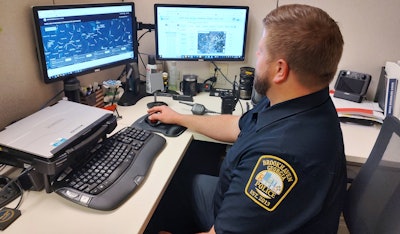 Officer Ben Shuler, a teleoperator, mans the DFR system inside police headquarters.Wayne Parham
Officer Ben Shuler, a teleoperator, mans the DFR system inside police headquarters.Wayne Parham
More than DFR
Currently the DFR drones are available five days a week, however, in the 2023 budget the city council funded the creation of two fulltime officers/teleoperators dedicated to the drone program. When those positions are staffed, Brookhaven drones will be available seven days a week and 12 hours per day.
The drone program has a total of 15 unmanned aircraft from manufacturers that include DJI, Brinc Drones, and Autel Robotics. Ayana’s office is jam packed with case after case of drones and related equipment. The department also has specialty drones, such as the Brinc Lemur S that is equipped with glass-breaking capabilities.
Cases with smaller drones are kept just outside Ayana’s office so patrol officers can grab them when they come on duty. Currently, the department has 16 certified drone pilots with FAA Part 107 licenses.
One of the first tactical drone deployments for Brookhaven was in Sandy Springs where a male had beaten a girl and held her hostage. She escaped, and a SWAT team surrounded the home. But nobody would come to the door and the female had reported the suspect was armed with an AK-47. After SWAT blasted the door, the drone flew in and located the AK-47 leaning against the bed. After a thorough search by the drone, it was determined the suspect was no longer inside.
Ayana says other agencies often reach out to Brookhaven and ask advice on what drone they need to purchase. That is not a simple answer.
“I tell them all the time, what is your focus? What's your mission? We have so many drones in here because we have so many different missions. Each mission may require a different type of drone,” he says.
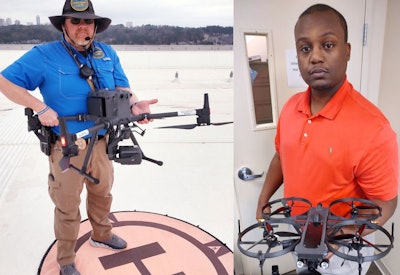 Sgt. Matt Murray, a rooftop pilot, is shown above left with a DJI Matrice 300 RTK. Lt. Abrem Ayana, above right, holds a Lemur S by Brinc Drones, one of many non-DFR drones in the fleet.Wayne Parham
Sgt. Matt Murray, a rooftop pilot, is shown above left with a DJI Matrice 300 RTK. Lt. Abrem Ayana, above right, holds a Lemur S by Brinc Drones, one of many non-DFR drones in the fleet.Wayne Parham
The Drone Fleet
Drones flown by the Brookhaven Police Department are:
· Autel Robotics — Evo ii Pro 6k
· DJI — Mavic 2 Enterprise Dual
· DJI — MATRICE 300 RTK
· DJI — MATRICE 300 RTK
· DJI — M30T
· DJI —AVATA PRO VIEW COMBO
· DJI —AVATA PRO VIEW COMBO
· AUTEL Robotics — Evo II 640T Enterprise V3
· Brinc Drones — Lemur S
· DJI — Mavic Mini 3 Pro
· DJI — Mavic Mini 3 Pro
· DJI — Mavic Mini
· DJI — Mavic Mini
· DJI — Mavic Mini
· DJI — Mavic Mini






